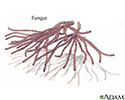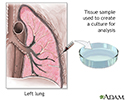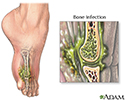Blastomycosis
North American blastomycosis; Gilchrist diseaseBlastomycosis is an infection caused by breathing in the Blastomyces dermatitidis fungus. This fungus is found in decaying wood and soil.
Causes
You can get blastomycosis by contact with moist soil, most commonly where there is rotting wood and leaves. The fungus enters the body through the lungs, where the infection starts. The fungus can then spread to other parts of the body. The disease may affect the skin, bones and joints, and other areas.
Blastomycosis is rare. It occurs in the central and southeastern United States, and in Canada, India, Israel, Saudi Arabia, and Africa.
The key risk factor for the disease is contact with infected soil. It most often affects people with weakened immune systems, such as those with HIV/AIDS or who have had an organ transplant, but it can also infect healthy people. Men are more likely to be affected than women.
HIV/AIDS
Human immunodeficiency virus (HIV) is the virus that causes acquired immunodeficiency syndrome (AIDS). When a person becomes infected with HIV, the ...

Symptoms
Lung infection may not cause any symptoms. Symptoms may be seen if the infection spreads. Symptoms may include:
- Joint pain
-
Chest pain
Chest pain
Chest pain is discomfort or pain that you feel anywhere along the front of your body between your neck and upper abdomen.
 ImageRead Article Now Book Mark Article
ImageRead Article Now Book Mark Article - Cough (may produce brown or bloody mucus)
- Fatigue
- Fever
- Night sweats
- General discomfort, uneasiness, or ill feeling (malaise)
Malaise
Malaise is a general feeling of discomfort, illness, or lack of well-being.
 ImageRead Article Now Book Mark Article
ImageRead Article Now Book Mark Article - Muscle pain
-
Unintentional weight loss
Unintentional weight loss
Unexplained weight loss is a decrease in body weight, when you did not try to lose the weight on your own. Many people gain and lose weight. Uninten...
Read Article Now Book Mark Article
Most people develop skin symptoms when the infection spreads. You may get papules, pustules, or nodules on exposed body areas.
Pustules
Pustules are small, inflamed, pus-filled, blister-like sores (lesions) on the skin surface.

The pustules:
- May look like warts or ulcers
- Are usually painless
- Vary in color from gray to violet
- May appear in the nose and mouth
- Bleed easily and form ulcers
Exams and Tests
Your health care provider will perform a physical exam. You'll be asked about your medical history and symptoms.
If the provider suspects you have a fungal infection, diagnosis can be confirmed by these tests:
-
Chest CT scan
Chest CT scan
A chest CT (computed tomography) scan is an imaging method that uses x-rays to create cross-sectional pictures of the chest and upper abdomen....
 ImageRead Article Now Book Mark Article
ImageRead Article Now Book Mark Article -
Chest x-ray
Chest x-ray
A chest x-ray is an x-ray of the chest, lungs, heart, large arteries, ribs, and diaphragm.
 ImageRead Article Now Book Mark Article
ImageRead Article Now Book Mark Article - Skin biopsy
Biopsy
A biopsy is the removal of a small piece of tissue for lab examination.
 ImageRead Article Now Book Mark Article
ImageRead Article Now Book Mark Article -
Sputum culture and exam
Sputum culture
Routine sputum culture is a laboratory test that looks for germs that cause infection. Sputum is the material that comes up from air passages when y...
 ImageRead Article Now Book Mark Article
ImageRead Article Now Book Mark Article - Urinary antigen detection
Antigen
An antigen is any substance that causes your immune system to produce antibodies against it. This means your immune system does not recognize the su...
 ImageRead Article Now Book Mark Article
ImageRead Article Now Book Mark Article - Tissue biopsy and culture
-
Urine culture
Urine culture
A urine culture is a lab test to check for bacteria or other germs in a urine sample. It can be used to check for a urinary tract infection in adults...
 ImageRead Article Now Book Mark Article
ImageRead Article Now Book Mark Article
Treatment
You may not need to take medicine for a mild blastomycosis infection that stays in the lungs. Your provider may recommend the following antifungal medicines when the disease is severe or spreads outside of the lungs.
- Fluconazole
- Itraconazole
- Ketoconazole
Amphotericin B may be used for severe infections.
Follow up regularly with your provider to make sure the infection does not return.
Outlook (Prognosis)
People with minor skin sores (lesions) and mild lung infections usually recover completely. The infection can lead to death if not treated.
Possible Complications
Complications of blastomycosis may include:
- Large sores with pus (abscesses)
Abscesses
An abscess is a collection of pus in any part of the body. In most cases, the area around an abscess is swollen and inflamed.
 ImageRead Article Now Book Mark Article
ImageRead Article Now Book Mark Article - Skin sores can lead to scarring and loss of skin color (pigment)
- Return of the infection (relapse or disease recurrence)
- Side effects from medicines such as amphotericin B
When to Contact a Medical Professional
Contact your provider if you have symptoms of blastomycosis.
Prevention
Avoiding travel to areas where the infection is known to occur may help prevent exposure to the fungus, but this may not always be possible.
References
Elewski BE, Hughey LC, Hunt KM, Hay RJ. Fungal diseases. In: Bolognia JL, Schaffer JV, Cerroni L, eds. Dermatology. 5th ed. Philadelphia, PA: Elsevier; 2025:chap 77.
Gauthier GM, Klein BS. Blastomycosis. In: Bennett JE, Dolin R, Blaser MJ, eds. Mandell, Douglas, and Bennett's Principles and Practice of Infectious Diseases. 9th ed. Philadelphia, PA: Elsevier; 2020:chap 264.
Thompson GR, Miceli MH. Endemic mycoses. In: Goldman L, Cooney KA, eds. Goldman-Cecil Medicine. 27th ed. Philadelphia, PA: Elsevier; 2024:chap 308.
-
Respiratory system - illustration
Air is breathed in through the nasal passageways, travels through the trachea and bronchi to the lungs.
Respiratory system
illustration
-
Fungus - illustration
Fungal infections are caused by microscopic organisms (fungi) that can live on the skin. They can live on the dead tissues of the hair, nails, and outer skin layers.
Fungus
illustration
-
Lung tissue biopsy - illustration
To obtain a sample of lung tissue for biopsy, a needle is inserted within the lung and a sample is withdrawn and sent to the laboratory. The laboratory test isolates and identifies organisms that cause infection from the lung specimen. A lung needle biopsy culture is performed when infection of the lung is suspected and sputum or bronchoalveolar lavage cultures have not identified the cause of the infection.
Lung tissue biopsy
illustration
-
Osteomyelitis - illustration
Osteomyelitis is infection in the bones. Often, the original site of infection is elsewhere in the body, and spreads to the bone by the blood. Bacteria or fungus may sometimes be responsible for osteomyelitis.
Osteomyelitis
illustration
-
Respiratory system - illustration
Air is breathed in through the nasal passageways, travels through the trachea and bronchi to the lungs.
Respiratory system
illustration
-
Fungus - illustration
Fungal infections are caused by microscopic organisms (fungi) that can live on the skin. They can live on the dead tissues of the hair, nails, and outer skin layers.
Fungus
illustration
-
Lung tissue biopsy - illustration
To obtain a sample of lung tissue for biopsy, a needle is inserted within the lung and a sample is withdrawn and sent to the laboratory. The laboratory test isolates and identifies organisms that cause infection from the lung specimen. A lung needle biopsy culture is performed when infection of the lung is suspected and sputum or bronchoalveolar lavage cultures have not identified the cause of the infection.
Lung tissue biopsy
illustration
-
Osteomyelitis - illustration
Osteomyelitis is infection in the bones. Often, the original site of infection is elsewhere in the body, and spreads to the bone by the blood. Bacteria or fungus may sometimes be responsible for osteomyelitis.
Osteomyelitis
illustration
Review Date: 8/29/2024
Reviewed By: Jatin M. Vyas, MD, PhD, Roy and Diana Vagelos Professor in Medicine, Columbia University Vagelos College of Physicians and Surgeons, Division of Infectious Diseases, Department of Medicine, New York, NY. Also reviewed by David C. Dugdale, MD, Medical Director, Brenda Conaway, Editorial Director, and the A.D.A.M. Editorial team.






